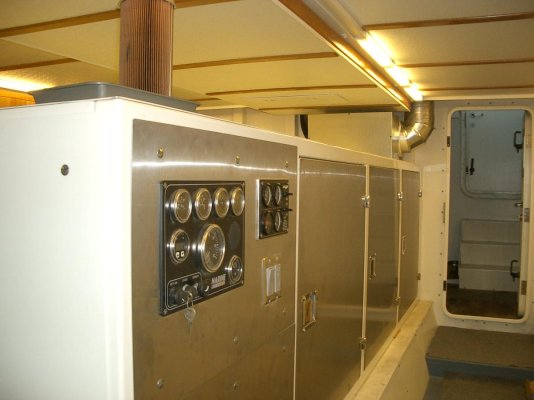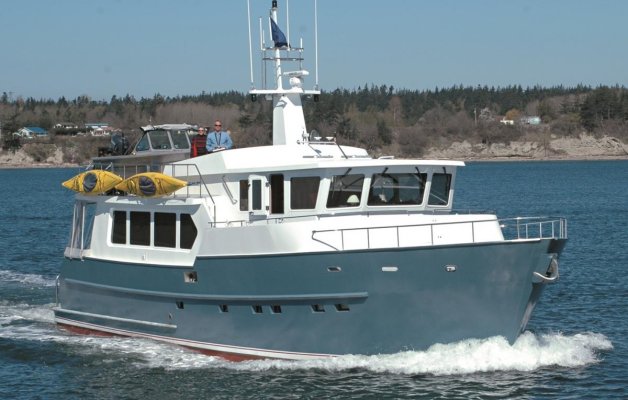Sorry for taking so long to respond to all these much appreciated comments and questions. Been a particularly busy week here at Naval Yachts with not only boat building but also building the new shipyard so I’m a bit behind on Emails, blogs and the like. I’ll go back and answer some of the individual posts but thought I could respond to some of the common questions and some of what led us to go with putting the Gardner 6LXB engine in a smaller volume dedicated engine room enclosure rather than the more typical larger full beam engine room between bulkheads.
As we have done with all aspects of designing our 24m XPM boat Möbius, we have tried to take a “do over” or blank slate type of approach by trying to use the sum total of all our past experiences on passage making boats, along with all the lessons learned by others, to design and build the “just right, just for us” Goldilocks boat. We have been doing this by creating a set of first principles and fundamental requirements and then design everything based on this “design envelope”. Sounds easy but this took us over a year to develop all together and we have come to value it more every step of the design and now build process. For those interested, the full description of our design requirements is in an
early post on our Mobius.World blog here.
After all our years and nautical miles it was quite a challenge to try to start with no preconceived notions of “this is how it is always done” and instead stay true to the fundamentals that we have set out for each space or system. On the one hand we definitely wanted to take maximum advantage of all our past experiences as well as “standing on the shoulders of giants” by taking into account the lessons learned and recommendations from experts and others before us, and yet we also want to take a fresh approach and rethink each space and system such that it best meets the fundamental requirements we have laid out and is open to new ideas and ways of meeting our goals. So as oxymoronic as it may sound we try to use our design envelop “box” to help us think outside all other boxes.
In the case of the engine room, the fundamental requirements that we worked from were grouped into things we wanted to minimize and those which we wanted to maximize. Specifically we set out to design an engine room that would minimize heat, noise and maintenance and simultaneously maximize accessibility, ventilation, safety, longevity and comfort. In the interest of brevity, not usually one of my strong points, here is a bulleted outline of the specifics of how we addressed each of these requirements.
MINIMIZE:
• HEAT
o Reduce heat generation wherever possible by keeping as many such items outside ER
o Ideal = Nothing but the engine in the engine room.
o Minimize heat from engine into ER:
o Water cooled exhaust manifold
o Jacketed exhaust lines
o Wet exhaust with water separator
o External rectifiers & regulators mounted outside ER
• NOISE
o Contain all engine/CPP related noises within the ER space
o Significantly over insulate all ER surfaces with >50mm fire rated EPDM
o Wet exhaust with water separator to exit sea chest
o 50mm thick engine beds
o Integral water tanks on either side of engine beds
• MAINTENANCE
o No heat or vibration going to other systems and equipment by keeping them outside ER
o ER surfaces, walls, ceiling, floor smaller and easy to clean materials
o Contain the bilge area to be only within the ER and sloped forward
MAXIMIZE:
• ACCESSIBILITY for working on engine & CPP
o Headroom height > 2m
o Space between engine & walls > 800mm
o Space below oil sump > 300mm
o Nothing mounted on ER walls
o Floor area clear of any equipment
o Full sized overhead dogged hatch large enough to Re/Re engine & CPP assembly
• LONGEVITY of all machinery and equipment within the ER
o Move all equipment possible from ER to Workshop area
o Maximum supply of cool air, passive with fan assist
o No heat & vibration affecting other systems such as fuel, electrical, water maker, boiler, chiller, etc.
• VENTILATION
o Venting 40% over both recommended VCR Volume Change Rates and engine combustion air rates
o Delta-T < 25F/14C (air temp @ intake manifold – air temp @ inlet vent grill)
o Outlet airflow 15% higher than inlet
o Max intake manifold air temp < 122F/50C
o Dedicated engine air vent boxes & ducting (details below)
o More air changes per hour w/ smaller volume, vents & fans
o Lowered heat retention w/ outlet fans
• SAFETY
o All electrical items, batteries, rectifiers, regulators located outside ER
o All fuel systems located outside ER; filters, Alfa Laval
o Fully contained and fire proof ER
• COMFORT
o Maximum amount of air and light into ER via full size hinged ceiling hatch
o Keep heat & noise isolated from adjacent Workshop space (and rest of boat)
As I noted above, one of the key ways we are meeting our design requirements for the ER is by having 2 dedicated ER vent boxes on the Aft Deck so here is a quick summary of the main features of these
VENT BOXES:
• Aluminium vent boxes built into Aft Deck (one inlet air, one outlet)
• Sized and located to have no down flooding through full 360 degree roll over during self righting
• Demister grills to reject any water entry & remove humidity in inlet air
• Short straight Dedicated in/out ER vent ducting
• Inlet venting at floor, outlet vent at ceiling
• Automatic Fire dampners w/ manual override
• Dedicated fans on exhaust vent, run as needed (thermo switch & manual) and on timer after engine shutdown
• Solar powered vents for longer times at anchor or when leaving the boat
I fully understand that many of you would still prefer to have a full size ER but you can now perhaps understand our reasoning in going with this dedicated ER enclosure design and why it is “just right, just for us”.
Thanks very much for all your suggestions and comments and I look forward to more.
All very much appreciated and I will go back and respond to some of the more specific questions in earlier posts here.
- Wayne



 You can read over my other post here where I have tried to outline our thinking and criteria that led to our decision to go with this smaller dedicated ER Enclosure and you can see what you think.
You can read over my other post here where I have tried to outline our thinking and criteria that led to our decision to go with this smaller dedicated ER Enclosure and you can see what you think.

